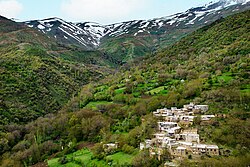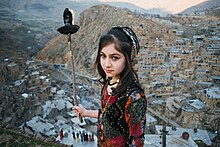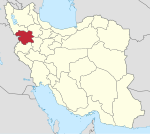Kurdistan province
Kurdistan Province
Persian:استان کردستان | |
|---|---|
| استان کردستان | |
 Miyanevillage | |
 Location of Kurdistan Province within Iran | |
| Coordinates:35°35′N46°53′E/ 35.583°N 46.883°E[1] | |
| Country | Iran |
| Region | Region 3 |
| Capital | Sanandaj |
| Counties | 10 |
| Government | |
| •Governor-general | Arash Zarehtan Lahoni |
| Area | |
| • Total | 29,137 km2(11,250 sq mi) |
| Population (2015)[2] | |
| • Total | 1,603,011 |
| • Density | 55/km2(140/sq mi) |
| Time zone | UTC+03:30(IRST) |
| Main language(s) | Persian(official) local languages:[3] Ardalanlanguages Kurdish |
| HDI(2017) | 0.743[4] high·30th |
Kurdistan province(Persian:استان کردستان)[a]is one of 31provincesof Iran. The province is 28,817 km2in area and its capital is the city ofSanandaj.[7]
Kurdistan province is in the west of Iran, inRegion 3.It borders theKurdistan RegionofIraqto the west, and the Iranian provinces ofWest Azerbaijanto the north,Zanjanto the northeast,Hamadanto the east, andKermanshahto the south.[8]It exists within bothIranian KurdistanandKurdistan.
History
[edit]
The earliest human occupation of Kurdistan dates back to the Paleolithic Period when Neanderthals lived in the Sirwan Valley of Kurdistan more than 40,000 years ago.[9]
Demographics
[edit]Language and ethnicity
[edit]Most of the people of this province speakKurdishand other languages such asAzerbaijaniandPersianare also common in this province.[10]
Iranian Kurds make up the majority of the population, but Iranian Azeris populate the eastern provincial borderlands. Most of the Kurdish population speakSorani Kurdish,butSouthern Kurdishis spoken in the eastern parts of the province, including inBijarandDezej,whileGoraniis the main language in many villages in the southwestern part of the province.Oghuz Turkicvarieties can be found in the far-eastern part of the province, including in the cities ofDelbaran,Pir Taj,Serishabad,Yasukand,andTup Aghaj.These varieties are described as distinct fromIranian Azerbaijani,although they are closely related to it. While not being the primary language in any settlement in the province,Persianis increasingly becoming thefirst language,especially among the population in the eastern parts of the province.[3][11]
Religion
[edit]A significant majority of the people of Kurdistan province follow theSunnidenomination ofIslam.A minority ofShia,YarsanismandChristianfollowers also live in this province.[12][13][14][15]

Population
[edit]At the time of the 2006 National Census, the province's population was 1,416,334 inhabitants in 337,179 households.[16]The following census in 2011 counted 1,493,645 living in 401,845 households.[17]The 2016 census measured the population of the province as 2,152,471 in 471,310 households.[2]
Administrative divisions
[edit]The population history and structural changes of Kurdistan Province's administrative divisions over three consecutive censuses are shown in the following table. Each county is named after the city that serves as its administrative capital.
| Counties | 2006[16] | 2011[17] | 2016[2] |
|---|---|---|---|
| Baneh | 116,773 | 132,565 | 158,690 |
| Bijar | 95,461 | 93,714 | 89,162 |
| Dehgolan[b] | — | 62,844 | 64,015 |
| Divandarreh | 82,628 | 81,963 | 80,040 |
| Ghorveh | 196,972 | 136,961 | 140,192 |
| Kamyaran | 104,704 | 105,996 | 102,856 |
| Marivan | 150,926 | 168,774 | 195,263 |
| Sanandaj | 409,628 | 450,167 | 501,402 |
| Saqqez | 205,250 | 210,820 | 226,451 |
| Sarvabad | 53,992 | 49,841 | 44,940 |
| Total | 1,416,334 | 1,493,645 | 1,603,011 |
Cities
[edit]According to the 2016 census, 1,134,229 people (over 70% of the population of Kurdistan Province) live in the following cities:[2]
| City | Population |
|---|---|
| Armardeh | 2,305 |
| Babarashani | 509 |
| Baneh | 110,218 |
| Bardeh Rasheh | 1,020 |
| Bijar | 50,014 |
| Bolbanabad | 3,193 |
| Buin-e Sofla | 1,518 |
| Chenareh | 455 |
| Dehgolan | 25,992 |
| Delbaran | 6,713 |
| Dezej | 2,219 |
| Divandarreh | 34,007 |
| Ghorveh | 78,276 |
| Kamyaran | 57,077 |
| Kani Dinar | 13,059 |
| Kani Sur | 1,284 |
| Marivan | 136,654 |
| Muchesh | 3,370 |
| Pir Taj | 1,199 |
| Saheb | 3,101 |
| Sanandaj | 412,767 |
| Saqqez | 165,258 |
| Sarvabad | 5,121 |
| Serishabad | 7,196 |
| Shuyesheh | 1,302 |
| Tup Aghaj | 1,645 |
| Uraman Takht | 3,176 |
| Yasukand | 3,490 |
| Zarrineh | 2,091 |
Most populous cities
[edit]The following sorted table lists the most populous cities in Kurdistan in 2016.[2]
| Rank | City | County | Population |
|---|---|---|---|
| 1 | Sanandaj | Sanandaj | 412,767 |
| 2 | Saqqez | Saqqez | 165,258 |
| 3 | Marivan | Marivan | 136,654 |
| 4 | Baneh | Baneh | 110,218 |
| 5 | Qorveh | Qorveh | 78,276 |
| 6 | Kamyaran | Kamyaran | 57,077 |
| 7 | Bijar | Bijar | 50,014 |
| 8 | Divandarreh | Divandarreh | 34,007 |
| 9 | Dehgolan | Dehgolan | 25,992 |
| 10 | Kani Dinar | Marivan | 13,059 |
Culture
[edit]Clothing
[edit]The people of this province have special clothes that they have been wearing for centuries. The important point about the clothes of the people of this province is that even after the spread ofmodernismall over the world, the people of this province still try to be faithful to their past traditions in the field oflifestyle.[11][19][20][21][22]
Dance and music
[edit]
Among the cultural symbols of Kurdistan people are Kurdish dance and singing. This cultural tradition is very popular not only in this province but also throughout the country.
Important annual celebrations
[edit]Chaharshanbeh Suri
[edit]Chaharshanbeh Suri or Charshanbeh Suri is an Iranian festival of the fire dance celebrated on the eve of the last Wednesday of the year, of ancientZoroastrianorigin. It is the first festivity of Nowruz, the Iranian New Year. In this celebration, people light fires on the mountains and on the roofs of houses, dance, rejoice and stomp their feet.[10][23][24][25]
Nowruz
[edit]


Nowruz is one of the most important ceremonies that has been celebrated by Iranians for millennia.Nowruzand related ceremonies are celebrated in the most opulent way possible in Kurdistan province. As the spring equinox, Nowruz marks the beginning of spring in the Northern Hemisphere, better i.e. the moment at which the Sun crosses the celestial equator and equalizes night and day is calculated exactly every year. Traditional customs of Nowruz include fire and water, ritual dances, gift exchanges, reciting poetry, symbolic objects and more.[10][26][27][28][29][30][31][32][33]
Economy
[edit]
The major activities of the inhabitants are agriculture and modern livestock farming. Wheat, barley, grains and fruits are the major agricultural products. The chemical, metal, textile, leather and food industries are the main industrial activities in this province. This province has one of the largest rates of unemployment in Iran. According to Iranian statistics, more than twenty thousand people depend on being akolbarfor sustenance.[34][12]
Colleges and universities
[edit]- Kurdistan University of Medical Sciences
- Tohid Medical Center
- University of Kurdistan
- Islamic Azad University of Sanandaj
See also
[edit]![]() Media related toKurdistan Provinceat Wikimedia Commons
Media related toKurdistan Provinceat Wikimedia Commons
![]() Kurdistan (province)travel guide from Wikivoyage
Kurdistan (province)travel guide from Wikivoyage
Notes
[edit]References
[edit]- ^OpenStreetMap contributors (24 May 2024)."Kurdistan Province"(Map).OpenStreetMap(in Persian).Retrieved24 May2024.
- ^abcde"Census of the Islamic Republic of Iran, 1395 (2016)".AMAR(in Persian). The Statistical Center of Iran. p. 12. Archived fromthe original(Excel)on 8 May 2022.Retrieved19 December2022.
- ^abMohammadirad, Masoud (2016)."Language distribution: Kordestan Province".Iran Atlas.
- ^"Sub-national HDI - Area Database - Global Data Lab".hdi.globaldatalab.org.Retrieved13 September2018.
- ^"ئەنجوومەنی دادوەری ئێران بەدواداچوون بۆ دۆسیەی گەندەڵی لە پارێزگای کوردستان دەکات".Naskurd(in Kurdish). Archived fromthe originalon 29 November 2022.Retrieved18 March2020.
- ^"Parêzgeha Kurdistanê qaremana pêşbirkên werzişên zorxaneyî yên Îranê".Sahar.16 September 2017.Retrieved18 March2020.
- ^Habibi, Hassan (12 September 1990)."Approval of the organization and chain of citizenship of the elements and units of the national divisions of Kurdistan province, centered in the city of Sanandaj".Islamic Parliament Research Center of the Islamic Republic of Iran(in Persian). Ministry of Interior, Defense Political Commission of the Government Board. Archived fromthe originalon 23 October 2018.Retrieved22 January2024.
- ^"همشهری آنلاین-استانهای کشور به ۵ منطقه تقسیم شدند (Provinces were divided into 5 regions)".Hamshahri Online(in Persian). 22 June 2014.Archivedfrom the original on 23 June 2014.
- ^Biglari, F and S. Shidrang (2019) Rescuing the Paleolithic Heritage of Hawraman, Kurdistan, Iranian Zagros, Near Eastern Archaeology 82 (4): 226-235.https://doi.org/10.1086/706536
- ^abcAhmady, Kameel.2023.From Border to Border(Comprehensive research study on identity and ethnicity in Iran), Scholars' Press publishes, Moldova.
- ^abAhmady, Kameel(25 January 2022)."A Peace-Oriented Investigation of the Ethnic Identity Challenge in Iran (A Study of Five Iranian Ethnic Groups with the GT Method)".International Journal of Kurdish Studies.8(1): 1–40.doi:10.21600/ijoks.1039049.ISSN2149-2751.
- ^abAhmady, Kameel(25 August 2022)."Ethnicity and Identities in Iran: Progress and Equality".International Journal of Kurdish Studies.8(2): 238–272.doi:10.21600/ijoks.1148638.ISSN2149-2751.
- ^Department Of State. The Office of Electronic Information, Bureau of Public Affairs (14 September 2007)."Iran".2001-2009.state.gov.Retrieved15 November2023.
- ^"The World Factbook — Central Intelligence Agency".7 November 2017. Archived fromthe originalon 7 November 2017.Retrieved15 November2023.
- ^"Mamouri, Ali (December 1, 2013)." Iranian government builds bridges to Sunni minority ". Al-Monitor. Retrieved January 25, 2015".
- ^ab"Census of the Islamic Republic of Iran, 1385 (2006)".AMAR(in Persian). The Statistical Center of Iran. p. 12. Archived fromthe original(Excel)on 20 September 2011.Retrieved25 September2022.
- ^ab"Census of the Islamic Republic of Iran, 1390 (2011)".Syracuse University(in Persian). The Statistical Center of Iran. p. 12. Archived fromthe original(Excel)on 19 January 2023.Retrieved19 December2022.
- ^Davodi, Parviz (8 August 1390)."Letter of approval regarding the reforms of country divisions in Kurdistan province".Islamic Parliament Research Center(in Persian). Ministry of Interior, Political-Defense Commission of the Government Board. Archived fromthe originalon 29 October 2011.Retrieved14 November2023.
- ^Condra, Jill (9 April 2013).Encyclopedia of National Dress [2 volumes].Santa Barbara, Calif: Bloomsbury Publishing USA.ISBN978-0-313-37637-5.
- ^"Kurdish photos – 'A little Kurdish girl' Archived 2008-10-22 at the Wayback Machine".Archived fromthe originalon 21 March 2012.Retrieved15 November2023.
- ^Foundation, Encyclopaedia Iranica."Welcome to Encyclopaedia Iranica".iranicaonline.org.Retrieved15 November2023.
- ^"Clothing".Kurdish Central.Retrieved15 November2023.
- ^"Persian fire-jumping festival delights Berkeley residents".The Daily Californian.13 March 2013.Retrieved15 November2023.
- ^Razavi, Mahboobeh (1 March 2019)."Chaharshanbe Suri: Experiencing Iran's Fiery Festival".SURFIRAN Mag.Retrieved15 November2023.
- ^"Encyclopædia Iranica",Wikipedia,9 November 2023,retrieved15 November2023
- ^They celebrate the new year, which they callChār shanba sur,on the first Wednesday of April, slightly later than the Iranian new year, Now-Ruz, on 21 March. (...). The fact that Kurds celebrate the Iranian new year (which they call “Nawrôz” in Kurdish) does not make them Zoroastrian "– Richard Foltz (2017). "The “Original” Kurdish Religion? Kurdish Nationalism and the False Conflation of the Yezidi and Zoroastrian Traditions ". Journal of Persianate Studies. Volume 10: Issue 1. pp. 93, 95
- ^Nations, United."International Nowruz Day".United Nations.Retrieved15 November2023.
- ^"Kurdish Newroz".The Kurdish Project.Retrieved15 November2023.
- ^Plimmer, Joe (21 March 2023)."Nowruz: Kurdish new year 2023 celebrations – in pictures".the Guardian.ISSN0261-3077.Retrieved15 November2023.
- ^"Nowruz: The Rebirth of Nature | Silk Roads Programme".en.unesco.org.Retrieved15 November2023.
- ^Khalid, Hewa Salam (2020)."Newroz from Kurdish and Persian Perspectives – A Comparative Study".Journal of Ethnic and Cultural Studies.7(1): 116–130.ISSN2149-1291.JSTOR48710250.
- ^"Nowruz Brings Kurdish Unrest In Iran's North West".Iran International.15 November 2023.Retrieved15 November2023.
- ^"Nowruz 2023: Kurdish new year celebrations in pictures".euronews.24 March 2023.Retrieved15 November2023.
- ^Fars News:The situation of kolbars vaguer than ever
Bibliography
[edit]- Ahmady, Kameel(2023).From Border to Border.Moldova: Scholars’ Press publishes.ISBN9786206769538.
- Maisel, Sebastian (21 June 2018).The Kurds.Santa Barbara, California Denver, Colorado: Bloomsbury Publishing USA. p. 236.ISBN978-1-4408-4257-3.
- Houtsma, Martijn Theodoor(1993).First Encyclopaedia of Islam, 1913-1936.Vol. 4 (1st ed.). Leiden: BRILL. p. 1140.ISBN90-04-09790-2.OCLC258059134.


